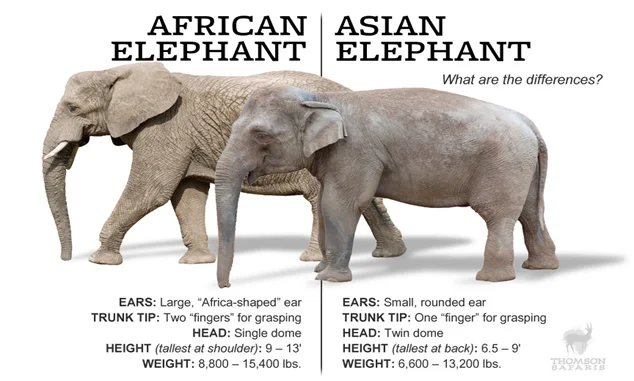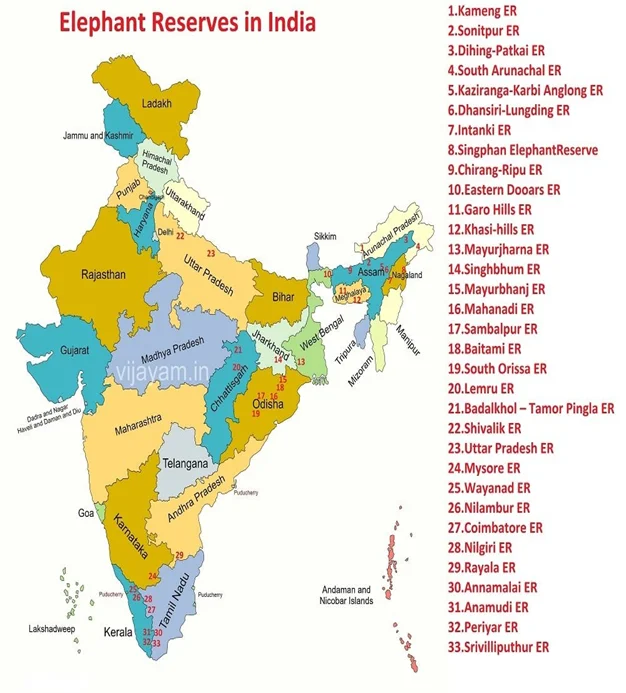Environment & Ecology
Context: Tamil Nadu Forest officials learn the ‘language of elephants’, thanks to calf rescue missions. Over the last one year, the department has successfully reunited three elephant calves that got separated from their herds in Nilgiris district of Tamil Nadu.

Asian Elephants and African Elephants:
About African Elephants:
- African Savanna (or bush) elephant
- IUCN Red List: Endangered
- African Forest Elephants
- IUCN Red List: Critically Endangered
- Note: Previously, IUCN listed both African elephants as “vulnerable”. But now it has opted to list them separately. It is after genetic evidence has proved that both are different species.
- Habitat: The distribution of African elephants is throughout the savannas of sub-Saharan Africa and the rainforests of Central and West Africa.
- African Savanna (or bush) elephant: They are larger animals that roam the plains of sub-Saharan Africa.
- African Forest Elephants: They are smaller animals that live in the forests of Central and West Africa.
Characteristics:
- African elephants are the largest land animals on Earth. They are slightly larger than Asian Elephants and can be identified by their larger ears. (Asian elephants have smaller, rounded ears)
- Elephants are matriarchal. It means they live in female-led groups. The matriarch is usually the biggest and oldest.
- Keystone Species: African elephants are keystone species, i.e., they play a critical role in their ecosystem. They are also known as “ecosystem engineers” as they shape their habitat in many ways.
About Asian Elephants:
The Asian elephant is the largest land mammal on the Asian continent. They inhabit dry to wet forest and grassland habitats in 13 range countries spanning South and Southeast Asia.
IUCN Red List: Endangered
CITES: Appendix I.
Wildlife (Protection) Act, 1972: Schedule I.
Elephant Reserves in India:
- The Indian elephant Elephas maximus occurs in the central and southern Western Ghats, North-east India, eastern India, and northern India and in some parts of southern peninsular India.
- It occurs in 16 of the 28 states in the country and is showing an increasing trend across its distributional range.
- Its population in 2007 was estimated to be in the range from 27,657 to 27,682, whereas in 2012 the population was estimated to be between 27,785 and 31,368.
- Karnataka has highest elephant population followed by Kerala, according to recent report of MoEF&CC.
PROJECT ELEPHANT : was launched by the Government of India in the year 1992 as a Centrally Sponsored Scheme with following objectives:
- To protect elephants, their habitat & corridors
- To address issues of man-animal conflict
- Welfare of captive elephants
- The Project is being mainly implemented in 16 States / UTs , viz. Andhra Pradesh, Arunachal Pradesh, Assam, Chhattisgarh, Jharkhand, Karnataka, Kerala, Maharashtra, Meghalaya, Nagaland, Orissa, Tamil Nadu, Tripura, Uttarakhand, Uttar Pradesh, West Bengal.
- The Ministry of Environment, Forest and Climate Change provides the financial and technical support to major elephant range states in the country through Project Elephant.

Source: The Hindu
Previous Year Questions
Q.1) With reference to Indian laws about wildlife protection, consider the following statements :
- Wild animals are the sole property of the government.
- When a wild animal is declared protected, such animal is entitled for equal protection whether it is found in protected areas or outside.
- Apprehension of a protected wild animal becoming a danger to human life is sufficient ground for its capture or killing.
Which of the statements given above is/are correct? (2022)
- 1 and 2
- 2 only
- 1 and 3
- 3 only
Q.2) With reference to Indian elephants, consider the following statements:
- The leader of an elephant group is a female
- The maximum gestation period can be 22 months
- An elephant can normally go on calving till the age of 40 years only
- Among the States in India, the highest elephant population is in Kerala
Which of the statements given above is/are correct? (2020)
- 1 and 2 only
- 2 and 4 only
- 3 only
- 1, 3 and 4 only
Q.3) Consider the following statements:
- Asiatic lion is naturally found in India only
- Double-humped camel is naturally found in India only
- One-horned rhinoceros is naturally found in India only
Which of the statements given above is/are correct? (2020)
- 1 only
- 2 only
- 1 and 3 only
- 1, 2 and 3













